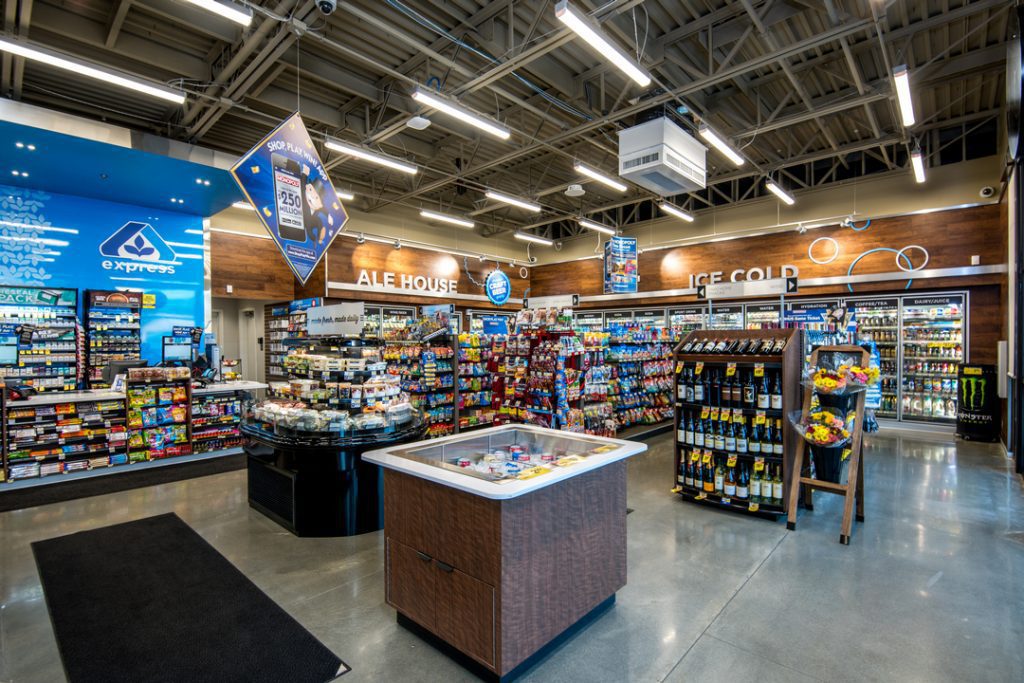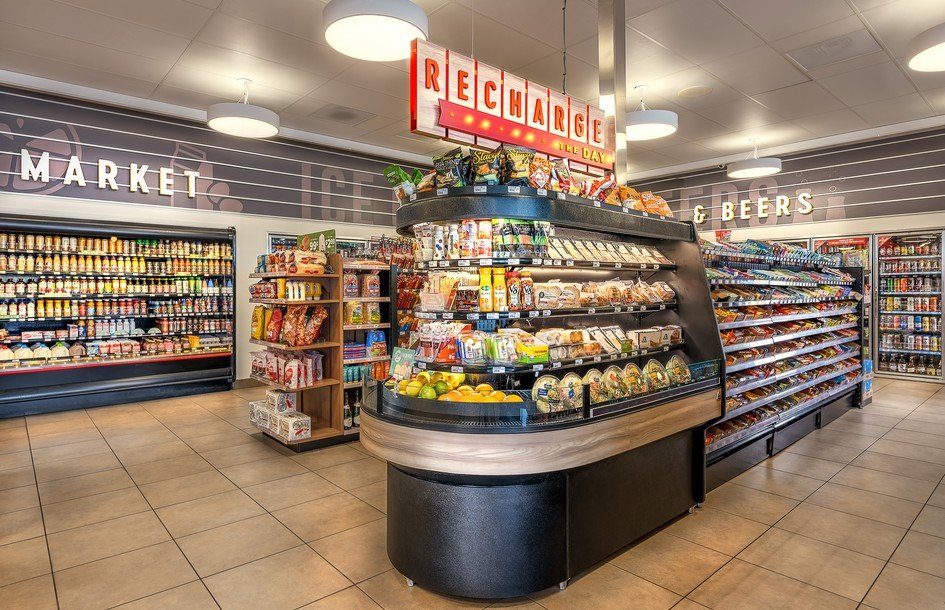Editor’s Note: This post was originally published in August 2021 and has been updated to include the latest trends and innovations.

New c-store design trends are driving the growth of upmarket convenience stores featuring organic and better-for-you options, artisan coffee, craft beer and kombucha on tap.
Though convenience stores were once the last place you’d find healthy or locally produced food, a rebellious breed of neo-convenience stores is on the move throughout the US, with products updated for discerning, health-conscious consumers on the go.
The New C-Store: Less is More, and More is More
These next-generation convenience stores run the gamut from small-footprint “boutique” brands in city centers to the world’s largest c-store in (where else?) Texas.
Like a traditional c-store design, many are small enough for urban centers or corner gas stations. Other neo-convenience stores are large enough to include an on-site coffee bar, bakery, cafe, grill, or a co-located QSR.
“The trend toward larger c-store footprints is really taking off in the South,” observes Seth Maddox, Creative Director at King Retail Solutions. “We’re seeing c-stores that have a footprint comparable to grocery stores–45,000 to 50,000 square feet.”
The recently opened Buc-ee’s New Braunfels, Texas, store is the largest convenience store in the world at 66,335 square feet. It includes a coffee bar that’s the size of a free-standing Starbucks, and an endless array of better-for-you snack options, many of them private-labeled.
These super-c-stores are appealing not just to motorists grabbing coffee and a pastry on the way to work. Increasingly, they are targeting recreational travelers. The Maverik group of c-stores emphasizes their customers’ love affair with the outdoors and the stores’ role in “fueling adventure” with gas and delicious food.
There’s also room in these large-format stores for pallet drops of bottled water, beer, and soft drinks–ideal for customers stocking up for a trip.
The rapid growth of recreational vehicle ownership and rentals is also driving the growth of large c-stores. According to market intelligence firm Mordor Intelligence, “The North American recreational vehicle (RV) market was valued at USD 33.95 billion in 2021 and is anticipated to reach USD 59.16 billion by 2027.”
It seems that everyone from Class A-driving retirees to Gen Z #vanlife couples are finding their way into the new c-stores.
While many of these c-stores may be grocery-store sized, they’re not trying to replace the grocery store. The shopping basket is still small in size. But many companies strategically target travelers who need to pick up recreational items en route to lakes and coastal destinations, including coolers, camp chairs, or beach toys.
Large travel-oriented c-stores also understand the power of spacious, clean restrooms, and commit generous square footage to these amenities. In another savvy nod to RVers, Golden Gate fuel provides complimentary dump stations at its newer c-store locations.
Better for You
Nearly all neo-convenience stores offer appealing, healthy grab-and-go food. Along with organic produce and meat, artisan cheeses, premium wines, and better-for-you options, they stock errand staples like eggs, milk, and toilet paper. And you’ll find plenty of the most frequently purchased c-store item, beer. (Think craft brews, merchandised in beer caves.)
Many neo-convenience stores emphasize healthy ingredients and sustainability, which come with a higher price point. While some take a purist’s approach, others aim for “crossover” appeal, stocking traditional c-store products as well. But while some of these upscale upstarts don’t sell cigarettes, sugary beverages, and lottery tickets, they don’t neglect that sacred c-store staple: snack foods. The Goods Mart motto is “snack good, feel good, do good.” (The company is known for its guest-curated snack boxes, which benefit a variety of charitable and social causes.)
Virtually every indy c-store brand touts a “curated” inventory. For customers overwhelmed at the prospect of wading into a 70,000 square foot supermarket to pick up a few items, the small footprint has enormous appeal. Shoppers can get in and out quickly, with just what they need, but without sacrificing quality.
C-Stores that “Think Local”
Many founders cite mom-and-pop corner stores and neighborhood bodegas as inspiration. Foxtrot Delivery Markets call themselves the “next generation corner store” and identify walkable urban corridors for their locations, which perform double duty as markets and distribution centers for their delivery business.
Neo-convenience stores often cite “local-first” criteria for the products that go on their shelves. They retail locally grown fresh produce and locally made foods. Some promote the products of marginalized groups or showcase local cottage food producers. Many have a give-back strategy to support local nonprofits.
C-store Design that Delivers Distinctive Customer Experiences
Traditional c-store interiors were designed to help customers find things fast and get on their way while maximizing impulse purchases; they resembled fast-food franchises.
“The branding used to be all about speed, more of a NASCAR aesthetic. But today, the one thing everyone wants to portray is freshness. No one wants to be the beer, cigs, and lottery place. They want to be the fresh panini and juice place.”
Seth Maddox, Creative Director at King Retail Solutions
Neo-convenience stores use design to build their brands and tell stories. From store fixtures to signage to merchandising methods, most express a distinct point of view.
Denver-based Choice Market, which sells fuel, employs a simple aesthetic at its four locations. With sans-serif signage, subway tile, and functional fixtures, the stores’ designs appeal to minimalism-loving Millennial and Gen Z customers.
Foxtrot Markets evoke the cozy, hang-out vibe of a coffeehouse. Store designs feature airy spaces, good-mood playlists, and furniture that encourages lingering–despite the fact that delivery accounts for half its revenues. The company is not afraid to experiment with formats; Foxtrot’s Lincoln Park location is a hybrid corner store and ice cream shop that showcases Jeni’s, a local-favorite brand.
Convenience Al Fresco
Outdoor dining is becoming much more important to c-store design, a trend accelerated by the pandemic. It’s also another way to reinforce the brand value of “freshness.”
“75% of the stores we’ve designed in the last few years have incorporated outdoor seating or patios,” says Maddox. “And at many of these stores, we’re designing some kind of openable window or roll-up garage-style door to combine indoor and outdoor space.”
The Other C-store Fuel: Coffee
An excellent coffee program attracts a daily following, and many neo-c-stores have taken a page from the specialty coffee shop industry. A popular offering is an in-store coffee bar, replete with free wi-fi.
Alltown Fresh touts its Swiss-made bean-to-cup machines, as well as its organic, fair trade coffee, single-origin coffees, and small-batch roasting. Tennessee c-store chain Twice Daily is making a move toward neo-convenience, rolling out a White Bison-branded specialty coffee bar with sleek, state-of-the-art Modbar under-counter machines.
Sheetz exhorts customers to “Ditch the Coffee Shop” and features hand-made espresso beverages created on Italian espresso machines, made in the store, to order.Choice Markets feature a Method coffee bar. At The Goods Mart in New York, which describes itself as “a better-for-you, socially conscious neighborhood convenience store”, the vision is to “make the store accessible to everyone by democratizing the products we carry.” The store offers a $1.25 cup of gourmet coffee.
Niche to Mass Market
The neo-convenience store is being embraced by independent, boutique brands as well as large companies. Alltown Fresh is actually a new concept from Global Partners, a $12.6 billion public company that owns close to 300 c-stores, and owns or leases 1,600 gas stations. Its portfolio of traditional convenience store brands includes Xtra Mart, Honey Farms, T Bird, and Jiffy Mart.
Global Partners CEO Eric Slifka realized his healthy lifestyle and plant-based food choices were not available in the convenience sector, so the company developed a new concept. Alltown Fresh describes itself as a “chef-driven, handcrafted kitchen and local market.” Though fresh food normally comprises just 10% of c-store sales, at Alltown Fresh it drives 75% of revenues. For the customer who dashes in for a soda and a bag of chips, standard packaged fare is still on offer.
Alltown Fresh stores are co-located with gas stations and designed to appeal to travelers and people on the move. Offerings include fresh blended smoothies, kombucha on tap, and fair trade specialty “bean to cup” coffee. The chef-driven menu caters to a wide range of dietary needs and includes many plant-based options. Healthy breakfast sandwiches and fresh salads are some of its most popular choices.
Meal kits and catering are part of the lineup, expanding the definition of what makes a c-store “convenient.” The company has rolled out over 70 stores, all on the East Coast.

800-store Wawa, which has an extensive restaurant program, is now augmenting it with healthier and premium offerings. Sheetz and Casey’s offer fresh options along with made-to-order hot food and in-store dining. Chevron’s Extra Mile has developed an updated store format that includes healthier options like kombucha and fresh grab-and-go selections.
Grocery brands are also entering the c-store space. Boise-based Albertsons has opened seven fuel-driven Albertsons Express markets with updated c-store offerings, including premium wines and a beer cave.
Grocery giant Hyvee has entered the c-store fray with Fast & Fresh. These stores have a larger footprint than most c-stores. The layout features traditional convenience products on the left; on the right is a dizzying array of fresh offerings.
Befitting its mission as a “mealtime solution store,” there are abundant grab-and-go options, including chef-prepared meals from its in-house commissary, meal kits, a “take and bake” section, and a “short cut” section with prepped ingredients.
The company’s Mia Pizza anchors the center rear of the store, offering freshly-baked, customizable 6-minute pizzas, with dough made each day in-store. Fast & Fresh locations are often co-located with a Starbucks, but the stores sell coffee too. And drawing on its core competency in the grocery sector, “Aisles on Line” enables customers to place online orders for groceries from Hyvee that are delivered to lockers inside the Fast & Fresh.
7-Eleven is poised to attract affluent, environmentally-conscious customers with the installation of 500 new charging stations for electric vehicles. The convenience store chain has developed a 6,000-square-foot concept called 7-Eleven Lab Store, which includes a Laredo Taco Company serving up freshly prepared salsas, carne guisada, carnitas, and even house-made tortillas. It also offers kombucha, cold-pressed juices and smoothies, and organic groceries.
Convenient Technology
C-store brands are no longer content to be virtually indistinguishable, chosen primarily for their location. Like other retailers, they’re using technology to build robust loyalty programs.
In addition to fuel, car washes are another natural loyalty builder. More large-scale c-stores are adding automated car washes to their mix, making them even “stickier” to local customers. But loyalty programs, driven by mobile apps, are being used to cross-market products. A fuel customer may be offered a complimentary coffee or soda at a certain level of purchases.
While it may seem like these c-stores are all about extending the guest’s time in-store, they’re still committed to convenience and speed. BOPIS and delivery are becoming a more important part of the model. For example, a customer can pre-order their morning coffee and breakfast burrito before they arrive, and receive their order without stepping out of their car.
Self-checkout is also appearing in c-stores. Though consumers currently have an ambivalent relationship with self-checkout, there are many who prefer (and expect) it. In c-stores, one or two self-checkout stations are placed within view of cashiers, helping traffic flow during morning and afternoon rushes. Self-checkout can also ease staffing issues during the current labor shortage.
One downside of self-checkout in convenience: for two of its most popular categories, alcohol and tobacco, IDs must be checked and purchases rung up by a cashier.
No discussion of c-store disruption would be complete without the mention of Amazon Go c-stores. The company claims its small-footprint urban stores offer “true grab-and-go”, thanks to Amazon’s frictionless, cashierless, Just Walk Out technology. As of 2021, Amazon had opened close to 30 stores.
The Future of Convenience
The convenience sector is one of the most dynamic in retail today, a fertile zone for startups and new concepts. Whether rural, suburban, or urban, many communities throughout the US are still without enough options for food that’s both healthy and convenient.
Entrepreneurs with a unique offering can pilot new concepts and roll them out quickly. As c-store brands discover new ways to differentiate, consumer expectations will naturally increase.
But one of the most intriguing opportunities lies in the immense “installed base” of existing convenience stores. There is a remarkable opportunity to attract new, upscale customers–and improve the quality of life for the communities these brands serve.
